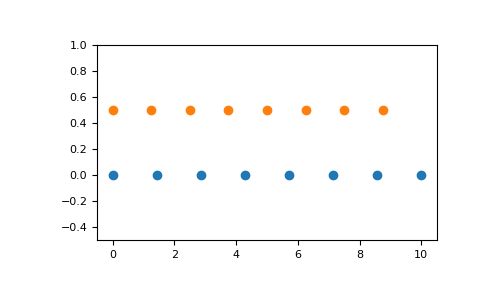学习大数据第四天:最小二乘法的Python实现
2016-04-25 12:27
483 查看
1.import numpy as np
np.pi
2. np.poly1d
class numpy.poly1d(c_or_r, r=0, variable=None)[source]
A one-dimensional polynomial class.
A convenience class, used to encapsulate “natural” operations on polynomials so that said operations may take on their customary form in code (see Examples).
Examples
Construct the polynomial

:
>>>
Evaluate the polynomial at

:
>>>
Find the roots:
>>>
These numbers in the previous line represent (0, 0) to machine precision
Show the coefficients:
>>>
Display the order (the leading zero-coefficients are removed):
>>>
Show the coefficient of the k-th power in the polynomial (which is equivalent to p.c[-(i+1)]):
>>>
Polynomials can be added, subtracted, multiplied, and divided (returns quotient and remainder):
>>>
>>>
asarray(p) gives
the coefficient array, so polynomials can be used in all functions that accept arrays:
>>>
>>>
The variable used in the string representation of p can be modified, using the variable parameter:
>>>
Construct a polynomial from its roots:
>>>
This is the same polynomial as obtained by:
>>>
3.np.linspace
numpy.linspace(start, stop, num=50, endpoint=True, retstep=False, dtype=None)[source]
Return evenly spaced numbers over a specified interval.
Returns num evenly spaced samples, calculated over the interval [start, stop].
The endpoint of the interval can optionally be excluded.
See also
arangeSimilar to linspace,
but uses a step size (instead of the number of samples).
logspaceSamples uniformly distributed in log space.
Examples
>>>
Graphical illustration:
>>>
(Source code, png, pdf)

np.pi
3.141592653589793
2. np.poly1d
numpy.poly1d
class numpy.poly1d(c_or_r, r=0, variable=None)[source]A one-dimensional polynomial class.
A convenience class, used to encapsulate “natural” operations on polynomials so that said operations may take on their customary form in code (see Examples).
| Parameters: | c_or_r : array_like The polynomial’s coefficients, in decreasing powers, or if the value of the second parameter is True, the polynomial’s roots (values where the polynomial evaluates to 0). For example, poly1d([1, 2, 3])returns an object that represents  , whereas poly1d([1, 2, 3], True) returns one that represents  . r : bool, optional If True, c_or_r specifies the polynomial’s roots; the default is False. variable : str, optional Changes the variable used when printing p from x to variable (see Examples). |
|---|
Construct the polynomial

:
>>>
>>> p = np.poly1d([1, 2, 3]) >>> print np.poly1d(p) 2 1 x + 2 x + 3
Evaluate the polynomial at

:
>>>
>>> p(0.5) 4.25
Find the roots:
>>>
>>> p.r array([-1.+1.41421356j, -1.-1.41421356j]) >>> p(p.r) array([ -4.44089210e-16+0.j, -4.44089210e-16+0.j])
These numbers in the previous line represent (0, 0) to machine precision
Show the coefficients:
>>>
>>> p.c array([1, 2, 3])
Display the order (the leading zero-coefficients are removed):
>>>
>>> p.order 2
Show the coefficient of the k-th power in the polynomial (which is equivalent to p.c[-(i+1)]):
>>>
>>> p[1] 2
Polynomials can be added, subtracted, multiplied, and divided (returns quotient and remainder):
>>>
>>> p * p poly1d([ 1, 4, 10, 12, 9])
>>>
>>> (p**3 + 4) / p (poly1d([ 1., 4., 10., 12., 9.]), poly1d([ 4.]))
asarray(p) gives
the coefficient array, so polynomials can be used in all functions that accept arrays:
>>>
>>> p**2 # square of polynomial poly1d([ 1, 4, 10, 12, 9])
>>>
>>> np.square(p) # square of individual coefficients array([1, 4, 9])
The variable used in the string representation of p can be modified, using the variable parameter:
>>>
>>> p = np.poly1d([1,2,3], variable='z') >>> print p 2 1 z + 2 z + 3
Construct a polynomial from its roots:
>>>
>>> np.poly1d([1, 2], True) poly1d([ 1, -3, 2])
This is the same polynomial as obtained by:
>>>
>>> np.poly1d([1, -1]) * np.poly1d([1, -2]) poly1d([ 1, -3, 2])
3.np.linspace
numpy.linspace
numpy.linspace(start, stop, num=50, endpoint=True, retstep=False, dtype=None)[source]Return evenly spaced numbers over a specified interval.
Returns num evenly spaced samples, calculated over the interval [start, stop].
The endpoint of the interval can optionally be excluded.
| Parameters: | start : scalar The starting value of the sequence. stop : scalar The end value of the sequence, unless endpoint is set to False. In that case, the sequence consists of all but the last of num + 1 evenly spaced samples, so that stop is excluded. Note that the step size changes when endpoint is False. num : int, optional Number of samples to generate. Default is 50. Must be non-negative. endpoint : bool, optional If True, stop is the last sample. Otherwise, it is not included. Default is True. retstep : bool, optional If True, return (samples, step), where step is the spacing between samples. dtype : dtype, optional The type of the output array. If dtype is not given, infer the data type from the other input arguments. New in version 1.9.0. |
|---|---|
| Returns: | samples : ndarray There are num equally spaced samples in the closed interval [start, stop] or the half-open interval[start, stop) (depending on whether endpoint is True or False). step : float Only returned if retstep is True Size of spacing between samples. |
arangeSimilar to linspace,
but uses a step size (instead of the number of samples).
logspaceSamples uniformly distributed in log space.
Examples
>>>
>>> np.linspace(2.0, 3.0, num=5) array([ 2. , 2.25, 2.5 , 2.75, 3. ]) >>> np.linspace(2.0, 3.0, num=5, endpoint=False) array([ 2. , 2.2, 2.4, 2.6, 2.8]) >>> np.linspace(2.0, 3.0, num=5, retstep=True) (array([ 2. , 2.25, 2.5 , 2.75, 3. ]), 0.25)
Graphical illustration:
>>>
>>> import matplotlib.pyplot as plt >>> N = 8 >>> y = np.zeros(N) >>> x1 = np.linspace(0, 10, N, endpoint=True) >>> x2 = np.linspace(0, 10, N, endpoint=False) >>> plt.plot(x1, y, 'o') [<matplotlib.lines.Line2D object at 0x...>] >>> plt.plot(x2, y + 0.5, 'o') [<matplotlib.lines.Line2D object at 0x...>] >>> plt.ylim([-0.5, 1]) (-0.5, 1) >>> plt.show()
(Source code, png, pdf)

相关文章推荐
- Python闭包
- python版本的读写锁操作方法
- python re 模块
- Python中的引用和拷贝浅析
- python2.X编码问题梳理
- Python简单实现enum功能的方法
- 初学python四:简单的输入输出
- 【LeetCode-345】Reverse Vowels of a String
- python 读取固定格式文件
- 初学python三:变量
- Python下载与安装
- [pip]安装和管理python第三方包
- 初学python二:数据类型
- python 爬虫
- Python学习(14)模块二
- 初学python一:零碎知识点
- 欢迎使用CSDN-markdown编辑器
- Python 用hashlib求中文字符串的MD5值
- python 循环定时器
- Ubuntu下安装Theano
